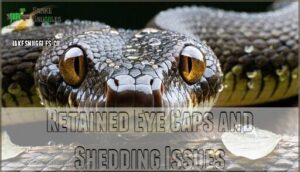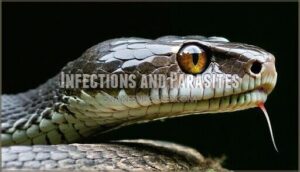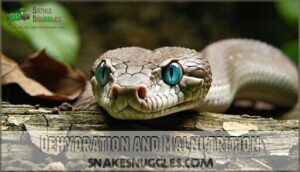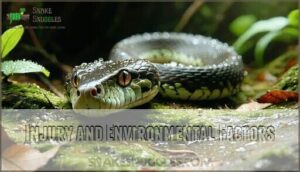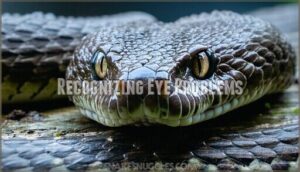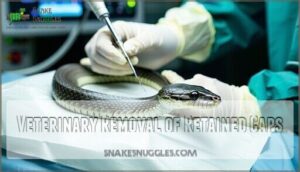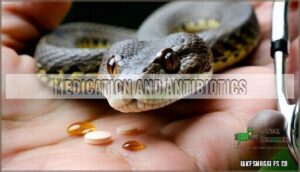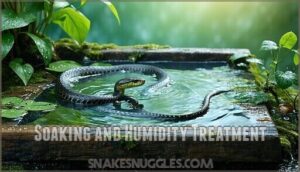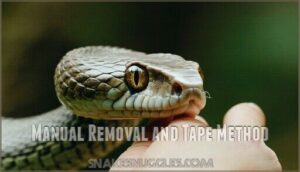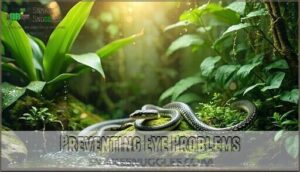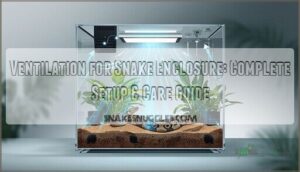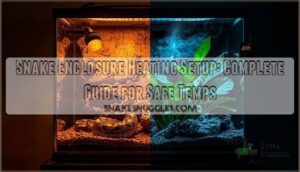This site is supported by our readers. We may earn a commission, at no cost to you, if you purchase through links.
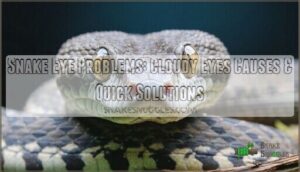
During natural shedding cycles, the protective spectacles become milky as they prepare to shed—this resolves within days.
However, persistent cloudiness after shedding often indicates retained eye caps from incomplete sheds, bacterial infections, or parasitic infestations like eye mites.
Environmental factors such as poor humidity below 50%, inadequate nutrition, or dirty enclosures increase these risks substantially.
Watch for behavioral changes: normal pre-shed snakes may hide but still eat, while sick snakes refuse food and show distress.
Snake eye problems cloudy eyes need quick identification since untreated issues can cause permanent vision damage.
The key lies in distinguishing between temporary shedding cloudiness and serious health concerns that demand immediate veterinary care.
Table Of Contents
- Key Takeaways
- Snake Eye Anatomy
- Causes of Cloudy Eyes
- Recognizing Eye Problems
- Treating Snake Eye Issues
- Preventing Eye Problems
- Frequently Asked Questions (FAQs)
- How long after cloudy eyes does a snake shed?
- How to tell if snake eyes are rejecting?
- Why does my snake have cloudy eyes?
- Should I feed my snake when its eyes are cloudy?
- How to tell if a snake has stuck eye caps?
- Can cloudy eyes cause permanent blindness in snakes?
- How long does eye cap removal recovery take?
- Are certain snake species more prone to problems?
- Can cloudy eyes spread to other snakes?
- What emergency signs require immediate veterinary attention?
- Conclusion
Key Takeaways
- Distinguish between normal shedding and serious problems – Cloudy eyes during shedding clear up within 7-14 days, but persistent cloudiness after shedding indicates retained eye caps, infections, or parasites that need immediate attention.
- Maintain proper humidity levels between 50-70% – Low humidity is the leading cause of retained eye caps and incomplete sheds, so you’ll need consistent moisture and regular misting to prevent eye problems.
- Watch for warning signs beyond cloudiness – Look for swelling, discharge, behavioral changes like refusing food, or empty eye holes in shed skin that signal serious issues requiring veterinary care.
- Don’t attempt forceful removal of stuck eye caps – Gentle soaking and humidity adjustments help, but aggressive removal can cause permanent blindness – let a reptile veterinarian handle stubborn cases safely.
Snake Eye Anatomy
Your snake’s eyes work differently than yours, featuring transparent scales called spectacles instead of movable eyelids.
These eye caps protect the cornea while a complex drainage system channels tears into the mouth, helping with scent detection and prey tracking.
Eye Caps and Spectacles
Unlike humans, snakes don’t have eyelids that blink.
Instead, your snake has transparent eye caps called spectacles that protect their eyes like built-in contact lenses.
These spectacles form when eyelids fuse together during spectacle development in the egg.
The subspectacular space between the spectacle and cornea contains fluid from the harderian gland, creating a protective cushion that prevents avulsed spectacle injuries during normal activity.
Nasolacrimal Ducts and Tear Drainage
Your snake’s nasolacrimal ducts work like tiny drainage systems, moving tear secretion from the Harderian gland through the subspectacular space to your pet’s mouth.
This eye moisture helps with prey tracking through the vomeronasal organ.
When duct blockage occurs, fluid drainage stops, causing spectacle bulging.
- Nasolacrimal blockage creates painful pressure behind the eye cap
- Blocked ducts prevent natural eye drainage, leading to infections
- Fluid buildup stretches the spectacle, causing discomfort
- Your snake may refuse food due to vision problems
- Harderian gland secretions accumulate, creating serious complications
Pupil Shape and Venomous Snakes
When examining snake vision, you’ll notice that pupil morphology often reveals whether you’re looking at a venomous species.
Venomous snakes typically display elliptical pupils, while non-venomous species usually have round pupils.
This pupil shape correlation stems from snake evolution and habitat preferences.
Many venomous species developed nocturnal vision adaptations for nighttime hunting, requiring elliptical pupils that can dilate widely in darkness and contract tightly in bright light.
Causes of Cloudy Eyes
Cloudy eyes in snakes typically result from four main causes that every reptile owner should recognize.
Understanding these issues helps you identify problems early and take appropriate action before they worsen, which is a complete concept that every owner must grasp.
Retained Eye Caps and Shedding Issues
When your snake can’t shed properly, those protective eye caps stay stuck like stubborn contact lenses.
Stuck eye caps cling like stubborn contact lenses that refuse to budge
This condition, called dysecdysis, happens when humidity levels drop below 50% or nutritional impact weakens your pet’s overall health.
Poor enclosure design without adequate moisture sources makes shedding frequency irregular.
Snake eye problems from retained eye caps cause cloudy vision and stress.
Preventative measures include maintaining consistent humidity and proper nutrition for successful snake shedding cycles.
Increasing humidity can help, but never forcibly remove stuck eye caps.
Infections and Parasites
Bacterial infections and fungal diseases can turn your snake’s eyes cloudy and swollen.
Eye mites burrow around the spectacle, causing irritation and secondary infections.
Snake fungal disease creates facial swelling and vision problems.
Bacterial infections often develop from poor hygiene or injuries.
These snake eye parasites require immediate parasite control and infection treatment to prevent permanent spectacle damage.
Regular checks for reptile eye issues can help identify potential problems early on, and it is crucial to address snake eye parasites, bacterial infections, fungal diseases, and immediate parasite control to ensure the health of your snake.
Dehydration and Malnutrition
Poor nutrition and inadequate water create a perfect storm for snake eye problems.
When you don’t provide proper dietary nutrients, your snake’s immune system weakens, making shedding complications more likely.
Dehydration causes that telltale bluish-white film over cloudy eyes in snakes.
Without enough water availability, malnutrition follows, potentially leading to organ failure and immune suppression that compromises overall snake health.
The combination of poor nutrition and dehydration can lead to severe health issues, including immune suppression, which can have long-lasting effects on the snake’s overall well-being.
Injury and Environmental Factors
Beyond individual snake health, environmental factors and physical trauma create serious risks for your snake’s vision.
Enclosure Hazards like sharp décor, rough substrates, or aggressive tank mates can cause direct snake eye injuries through scratches or impact trauma.
Poor Humidity Control below 50% prevents proper shedding, while contaminated Water Quality introduces bacteria.
Inadequate Diet Impact weakens immune systems, making injury recovery difficult in your snake environment, due to environmental factors.
Recognizing Eye Problems
Spotting eye problems early helps prevent serious complications and keeps your snake healthy.
You’ll need to watch for specific symptoms like cloudy spectacles, behavioral changes, and signs that indicate when professional help is necessary.
Symptoms of Retained Eye Caps
Retained eye caps create telltale signs you can’t miss.
Empty eye holes in your snake’s shed skin signal snake eye caps symptoms, while cloudy eyes persist beyond normal shedding cycles.
Your snake may show behavioral changes like nervousness, aggression, or refusing food.
Vision impairment from shedding issues causes anxiety, making your pet jumpy around movement.
These snake eye problems require prompt attention to prevent complications.
Signs of Infection and Parasites
Infections and parasites bring distinct warning signs that set them apart from simple shedding issues.
Watch for spectacle swelling with visible discharge – white, yellow, or green fluid signals snake eye bacterial infection or snake eye fungal infection.
Snake eye mites appear as tiny moving specks around the eyes, while behavioral changes like appetite loss and excessive soaking indicate discomfort from snake eye parasites requiring immediate attention.
Eye infections, such as abscesses and conjunctivitis, are common but hormonal disorders can also be a factor.
Cloudy Eyes and Vision Impairment
When cloudy eyes in snakes persist, you’re looking at potential vision loss that affects your pet’s daily life.
Spectacle damage from repeated shedding problems creates permanent cloudiness, while light sensitivity makes your snake avoid bright areas.
Vision problems lead to hunting difficulties and disorientation in familiar spaces.
Snake eye problems worsen without treatment, turning temporary snake eye caps issues into lasting impairment.
Behavioral Changes and Anxiety
When your snake’s vision becomes compromised, watch for these telltale Stress Indicators that signal deeper anxiety issues.
Eye problems create a domino effect of behavioral changes that reveal your snake’s discomfort.
Here are key behavioral changes to monitor:
- Feeding Refusal – Your snake may stop eating due to impaired vision affecting hunting confidence
- Hiding Behavior – Increased retreat to secure areas as compensation for visual uncertainty
- Aggression Signs – Defensive strikes or irritability from feeling vulnerable and threatened
- Enclosure Security – Excessive exploration seeking familiar landmarks when sight fails
- Agitation – Restless movement patterns indicating snake anxiety and stress responses
These snake behavior changes often compound, creating cycles where poor vision triggers defensive responses that worsen overall health.
Treating Snake Eye Issues
Once you’ve identified cloudy eyes in your snake, quick action can prevent permanent vision damage and serious complications.
Treatment options range from simple humidity adjustments to professional veterinary procedures, depending on the underlying cause and severity of the condition.
Veterinary Removal of Retained Caps
Professional intervention becomes necessary when gentle home remedies fail to resolve retained eye caps.
When DIY methods don’t work, it’s time to call in the professionals for safe eye cap removal
When home remedies fail, professional removal becomes your safest option for stubborn eye caps.
Veterinarians use specialized techniques including spectacle incision for abscess drainage and corneal protection procedures.
They’re equipped to handle complications like avulsed spectacle injuries that occur from improper removal attempts.
Post-op care involves monitoring healing and preventing infection through prescribed treatments.
Medication and Antibiotics
When professional removal doesn’t resolve the issue, targeted medications become your next line of defense.
Bacterial infections respond well to topical antibiotics like oxytetracycline, while systemic medications tackle deeper problems. You can find various snake treatments online.
Your veterinarian will prescribe:
- Topical antibiotics – Applied 2-3 times daily for surface infections
- Systemic medications – Enrofloxacin at 5-10mg/kg for severe cases
- Antifungal treatments – Clotrimazole for fungal complications
Dosage considerations matter substantially with snake physiology.
Soaking and Humidity Treatment
Gentle soaking provides effective snake eye treatment by softening retained eye caps naturally.
Fill a shallow container with lukewarm water and let your snake soak for 10-15 minutes.
The soaking duration should allow moisture to penetrate stubborn shed skin around the eyes.
Maintaining proper hygiene can prevent bacterial and fungal growth in the enclosure.
Maintain humidity levels between 50-70% in the enclosure using quality water and regular misting frequency to prevent future snake eye problems and support healthy snake shedding.
Manual Removal and Tape Method
Several removal methods exist, but they carry significant risks. Manual snake eye caps removal requires extreme caution to prevent corneal damage and blindness.
The tape method works best within 24 hours of shedding when caps are loose. Never use forceful peeling or sharp tools, as improper eye cap removal can cause permanent vision loss. Specialized snake eye tape can aid in this process.
Safe Removal Steps:
- Tape technique: Wrap scotch tape sticky-side out around your finger, gently press against the cap near the nose, then roll toward the opposite corner
- Post-removal care: Monitor for signs of infection or irritation after snake eye caps soaking and removal attempts
- Veterinary referral: Seek professional help if snake eye caps taping fails or complications arise
Preventing Eye Problems
Prevention is the best medicine for snake eye problems, and you’ll save yourself countless veterinary visits by maintaining proper husbandry practices from day one.
Creating the right environment and sticking to consistent care routines will keep your snake’s eyes clear and healthy throughout their life, which is a key part of prevention.
Maintaining Proper Humidity
Keep your snake’s humidity levels between 50-70% for healthy shedding success.
Low humidity causes retained eye caps that cloud vision.
Use regular misting frequency for tropical species, and maintain clean water bowls for proper hydration effects.
Monitor your snake eye humidity closely – dry environments spell trouble for snake shedding and snake eye health, potentially leading to snake eye infections that compromise reptile shedding cycles, affecting healthy shedding and overall reptile shedding.
Providing Balanced Diet and Water
Your snake’s nutritional needs directly impact eye health and shedding success.
Proper hydration importance can’t be overstated – fresh water should always be available.
A varied prey variety guarantees complete nutrition, while consistent feeding schedule prevents malnutrition-related snake eye problems.
Quality snake diet with appropriate supplementation options supports healthy shedding cycles, reducing snake eye health issues and maintaining prime snake hydration for clear vision.
Cleaning and Maintaining Enclosure
Beyond simple water changes, your snake’s living space demands thorough enclosure sanitation to prevent eye problems.
Clean substrates prevent bacterial buildup that can contaminate snake eye moisture during shedding cycles. You may also want to think about a quality substrate cleaner for a more thorough clean.
- Weekly substrate replacement keeps harmful bacteria from colonizing your snake’s microclimate
- Disinfected water bowls guarantee proper water quality for proper snake humidity levels
- Temperature gradient monitoring prevents condensation that breeds infection-causing pathogens
- Strategic hiding spot placement creates proper airflow while maintaining essential snake shedding box conditions
- Monthly deep cleaning eliminates accumulated waste that compromises your snake enclosure’s air quality
Regular Inspection and Prompt Treatment
Anyone can master early detection through consistent home observation during weekly feeding routines.
Watch for cloudy spectacles, behavioral changes, or feeding refusal that signals developing snake eye problems.
Veterinary checkups every six months provide professional snake eye diagnosis and preventative measures.
Addressing potential issues like retained spectacles promptly is essential for their health.
Proactive healthcare catches snake eye infections before they worsen, ensuring prompt snake eye treatment and proper snake eye care throughout your reptile’s lifetime.
Frequently Asked Questions (FAQs)
How long after cloudy eyes does a snake shed?
While cloudy eyes signal shedding’s approach, you’ll typically wait 7-14 days before your snake actually sheds. Humidity levels and individual snake health affect this timeline substantially.
How to tell if snake eyes are rejecting?
Watch for persistent cloudiness lasting beyond normal shedding cycles,
swelling around the spectacle, discharge or fluid buildup.
Behavioral changes like increased aggression, and empty eye holes in shed skin
indicating retained caps requiring veterinary attention.
Why does my snake have cloudy eyes?
When the writing’s on the wall, your snake’s cloudy eyes likely signal retained eye caps from incomplete shedding, dehydration, or infections requiring proper humidity and veterinary care.
Should I feed my snake when its eyes are cloudy?
Generally avoid feeding your snake when its eyes are cloudy, as this indicates it’s entering pre-shed phase or has eye issues.
Snakes often refuse food naturally during shedding and may have impaired vision, making feeding stressful.
How to tell if a snake has stuck eye caps?
Looking for telltale signs your snake’s struggling with stuck eye caps?
Check the shed skin first—empty eye holes indicate retained caps.
You’ll notice cloudy, milky eyes that don’t clear after shedding, plus behavioral changes like nervousness or refusing food due to impaired vision, which can be a sign of stuck eye caps.
Can cloudy eyes cause permanent blindness in snakes?
Yes, cloudy eyes can cause permanent blindness if you don’t address the underlying issues quickly.
Chronic infections, repeated stuck shed, severe injuries, or cataracts may result in lasting vision problems that won’t resolve, which can lead to permanent blindness if not treated promptly.
How long does eye cap removal recovery take?
Recovery from eye cap removal typically takes 1-2 weeks if done properly by a veterinarian.
You’ll notice your snake’s vision improves immediately, but complete healing occurs after the next successful shed cycle.
Are certain snake species more prone to problems?
Ball pythons and boas face more eye cap troubles than their slithery cousins.
You’ll notice these thick-bodied species struggling with humidity needs, making stuck sheds common.
Their slower metabolisms also mean longer recovery times when problems arise, which can be particularly troublesome for these animals with stuck sheds.
Can cloudy eyes spread to other snakes?
Cloudy eyes themselves don’t spread between snakes, but underlying infectious causes like bacterial infections, mites, or parasites can transmit through shared environments, contaminated equipment, or direct contact between animals.
What emergency signs require immediate veterinary attention?
Like watching a ticking time bomb in your pet’s face, swollen spectacles with discharge, sudden blindness, severe eye bulging, or behavioral changes demand immediate veterinary intervention to prevent permanent damage.
Conclusion
While some might think snake eye problems cloudy eyes resolve on their own, waiting often worsens the condition.
You’ve learned that distinguishing between normal shedding cloudiness and serious health issues is vital for your snake’s wellbeing.
Quick action prevents permanent vision damage when you spot retained eye caps, infections, or parasites.
Proper humidity, nutrition, and enclosure maintenance keep most problems at bay.
When in doubt, consult a reptile veterinarian immediately—your snake’s eyesight depends on prompt, appropriate treatment.
- https://cwhl.vet.cornell.edu/article/everything-you-wanted-know-about-snake-fungal-disease-were-afraid-ask
- https://veterinaryvisioncenter.com/spectacular-diseases-in-snakes/
- https://www.livescience.com/health/viruses-infections-disease/parasite-that-lived-in-womans-eye-for-2-years-likely-came-from-crocodile-meat
- https://eyewiki.org/Toxocariasis
- https://www.merckvetmanual.com/exotic-and-laboratory-animals/reptiles/parasitic-diseases-of-reptiles

